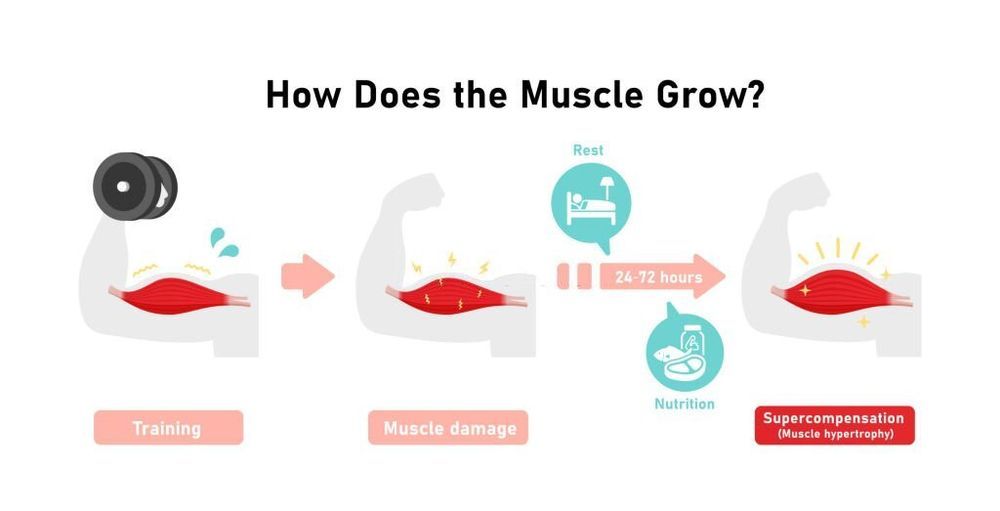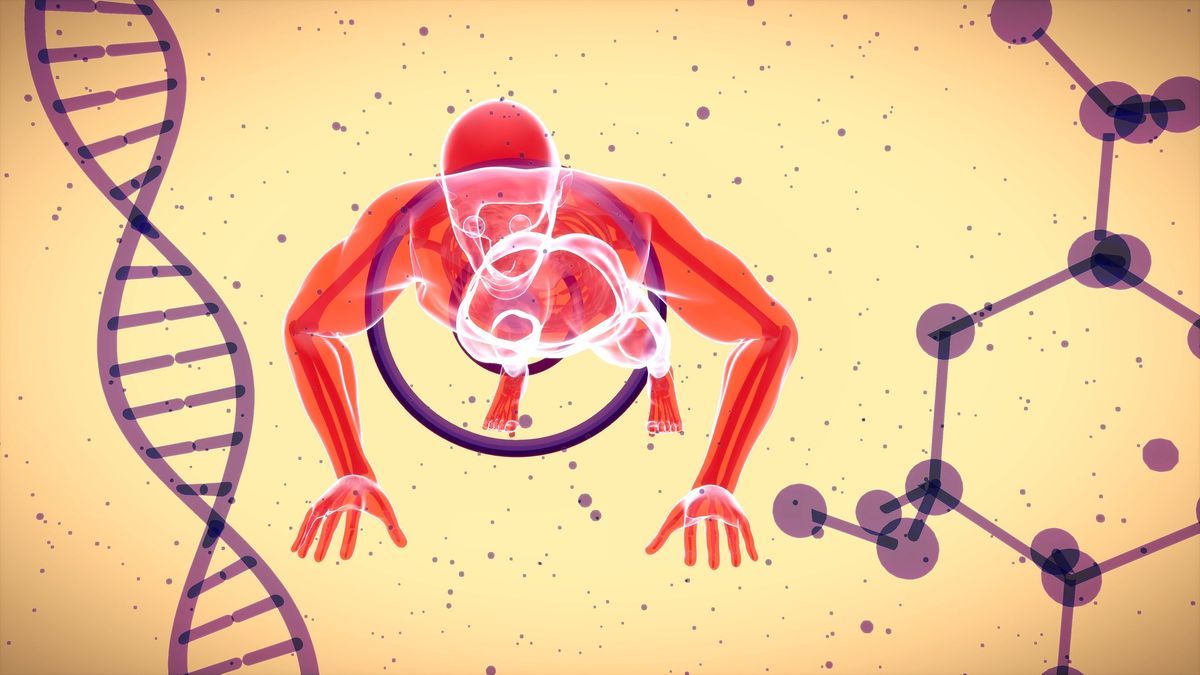To reinforce your confidence and erase any doubts you may have about whether it is possible to become a successful weightlifter at any stage of life, the basics of science will help you understand that there are physiological processes that you can start that will pay you back generously with results that will surprise you, maybe even astound you.
Science may not be the first thing that comes to mind when planning a muscle-building program, but it is important to ignore the old cliché s and anecdotal tales because safely and effectively building lean muscles is based entirely on scientific principles.
What does this mean? The scientific method means facts are established by test results that can be consistently repeated and not by opinions and traditions. The principles that apply to young weightlifters also apply to middle-aged weightlifters with the understanding that age requires some adjustments to achieve good results safely.
The Concept of Hypertrophy

Hypertrophy is an increase in the size of cells (or tissues) in response to various stimuli. A typical example is muscular hypertrophy in response to exercise.
The muscles we are concerned with are the 650 skeletal muscles that enable us to move and do work. They are made up of muscle fibers which, in turn, are built up from fine thread-like fibers called sarcomeres and myofibrils.
These muscle fibers are the fundamental elements of muscular contraction. When you flex a muscle or put it to work, it is within the fibers where the action is taking place. Keep these fibers in mind as we progress because they will be the units of growth that strengthen and build your muscles.
Muscles contract on command when certain nerves, called motor neurons, receive their signals from cells known as the sarcoplasmic reticulum. As your body becomes more conditioned, the signals will become more adept at getting your muscles to contract, and you will become stronger even before your muscles are much larger.
If you can train to activate your motor neurons effectively, it can jumpstart the processes to build bigger muscles to lift heavier weights. We’ll explain this in greater detail in the instructional chapters.
First, do the damage
The process of hypertrophy, the creation of muscle growth, begins with the damage done to muscle fibers during weightlifting.
The extreme effort of lifting or pulling heavy weights breaks down some of the muscle fibers that are involved in the hard work; this occurs at the cellular level and is completely normal. Your cells are being sacrificed by doing more work than they are accustomed to.
Next, repair the damage
To repair the damage, the cells use amino acid molecules to fuse into muscle fibers and to form new myofibrils out of strands of protein.
This is why protein needs to be an important component of diet for those who look to build muscle. it is the building block from which the myofibrils are constructed.
Importantly, during this process of hypertrophy:
- The myofibrils are not just repaired and rebuilt to their previous size but are made thicker and more numerous. They get slightly larger. They experience growth.
- Hypertrophy, or muscle growth, occurs when the production of muscle protein exceeds the previous pre-damage level. On a day-to-day basis, the muscle tissue increments are microscopic, but over time they accumulate, and muscle bulk becomes visible.
Satellite cells. The effectiveness of your hypertrophy is dependent upon what are known as satellite cells, which spur the growth of the myofibrils by increasing muscle protein nuclei and enabling the cells to divide more frequently.
The degree to which the satellite cells are active is dependent on the type and resistance of the exercises performed and the amount of stress that is placed on the muscles:
- The tension of the muscles is the result of progressively increasing the load that muscles are lifting and pulling, exceeding the amount of resistance they are accustomed to. So if you do bicep curls regularly with 15-pound dumbbells, your biceps and upper arms will retain their current muscle size and strength, but will not grow larger or stronger until you increase the weight to introduce greater resistance and cause stress.
- Damage to muscle cells and tissues releases immune system cells and inflammatory molecules that trigger the activation of satellite cells which, in turn, stimulate the growth of muscle tissue protein and boost hypertrophy.
One clear signal that this has occurred is muscle soreness in the hours and even days after your workout. This is due to the damage done during the workout, and it sets the stage for the over-rebuilding of muscle tissue to follow. Much of the soreness is from lactic acid buildup which will dissipate within a day or two.
Metabolic stress results from intense muscle tension and causes swelling of the cells in and around the muscle. It’s the result of the accumulation of blood, which is bringing extra oxygen to the tensed and damaged muscle fibers, plus the arrival of glycogen, the sugar molecules that provide the muscle cells with energy.
These effects may contribute to increased rebuilding, but much of the increased muscle size after the workout, while impressive, is temporary, and the muscles will return to their normal size as the fluids drain from the muscles.
Hormones
The role of hormones in building muscles is frequently debated. This is what is known today about the natural hormones in our bodies:
- Testosterone and insulin-like growth factor I (IGH-I) are the two most active hormones that contribute to muscle growth. While testosterone is at higher levels in men, women also have testosterone (and men also have estrogen), although a woman’s testosterone is at a lower level, which is a key reason that men can build muscles more readily than women.
- Both men and women can increase strength through weightlifting and other resistance exercises.
- While most of our testosterone is not free-roaming or available to affect muscle building, studies show that hard resistance exercise can release more testosterone, which can activate satellite cells, prevent or reduce protein breakdown, increase protein synthesis,
and stimulate other anabolic hormones. It may also encourage muscle cell receptors to be more sensitive to free testosterone. Testosterone can also increase the number of neurotransmitters at the site of damaged fiber, help activate tissue growth, and stimulate growth hormone responses.
The bottom line of natural hormones in our bodies is that resistance training can stimulate the release of hormones that further enhance the building of muscle and strength.
Hormones supplements? You are not encouraged to take hormone supplements to build muscle mass unless prescribed by a doctor following a blood test that identifies a hormone deficiency.
Rest and Muscle Loss vs. Muscle Gain
The muscle repairs and rebuilding we’ve been discussing do not occur during the time while you are actually lifting the weights and damaging the muscle fibers. Instead, muscle growth –hypertrophy takes place while you, and your muscles, are at rest.
It is during rest that recovery can take place. If the muscles continue to be worked, even to less extreme levels, there will be no opportunity for hypertrophy to do its work and, at best, no repairs can occur. Of greater concern, hard resistance exercise performed too soon after a good weightlifting session can have negative effects:
- If your muscles do not receive sufficient rest to prepare and conduct their repairs, you can reverse the protein-building process and allow your body to fall into a destructive or catabolic state. Over time, this can lead to muscle loss.
- The time needed for recovery and hypertrophy after a resistance exercise session is about 24 to 48 hours. So weightlifting that challenges any specific muscle group should not work that same muscle group for at least one day, preferably two days.
- If you follow a routine of doing total-body resistance workouts in a single workout session, then you should not have weightlifting or resistance sessions more than three times a week.
Weightlifters over 40. The need for rest and recovery is of special importance to you as a middle-aged weightlifter because your recovery time is longer as a function of your age and a slower metabolism. A two-day rest and recovery period after each weightlifting session is ideal for you.
Up the protein. During the rest and recovery days, your diet should be rich in protein since the amino acids that make up protein molecules are needed for the repair of muscle fibers. We’ll cover everything you need to know about diet in a later chapter, but for now, assume that you will want to have more meat, fish, dairy, and eggs, all of which are high in complete protein.
Vegetarians and vegans can increase their consumption of beans and other legumes, plus soybeans, buckwheat, and quinoa, which are among the few plant sources of complete protein, including the nine essential amino acids that our bodies need to get from our food.











